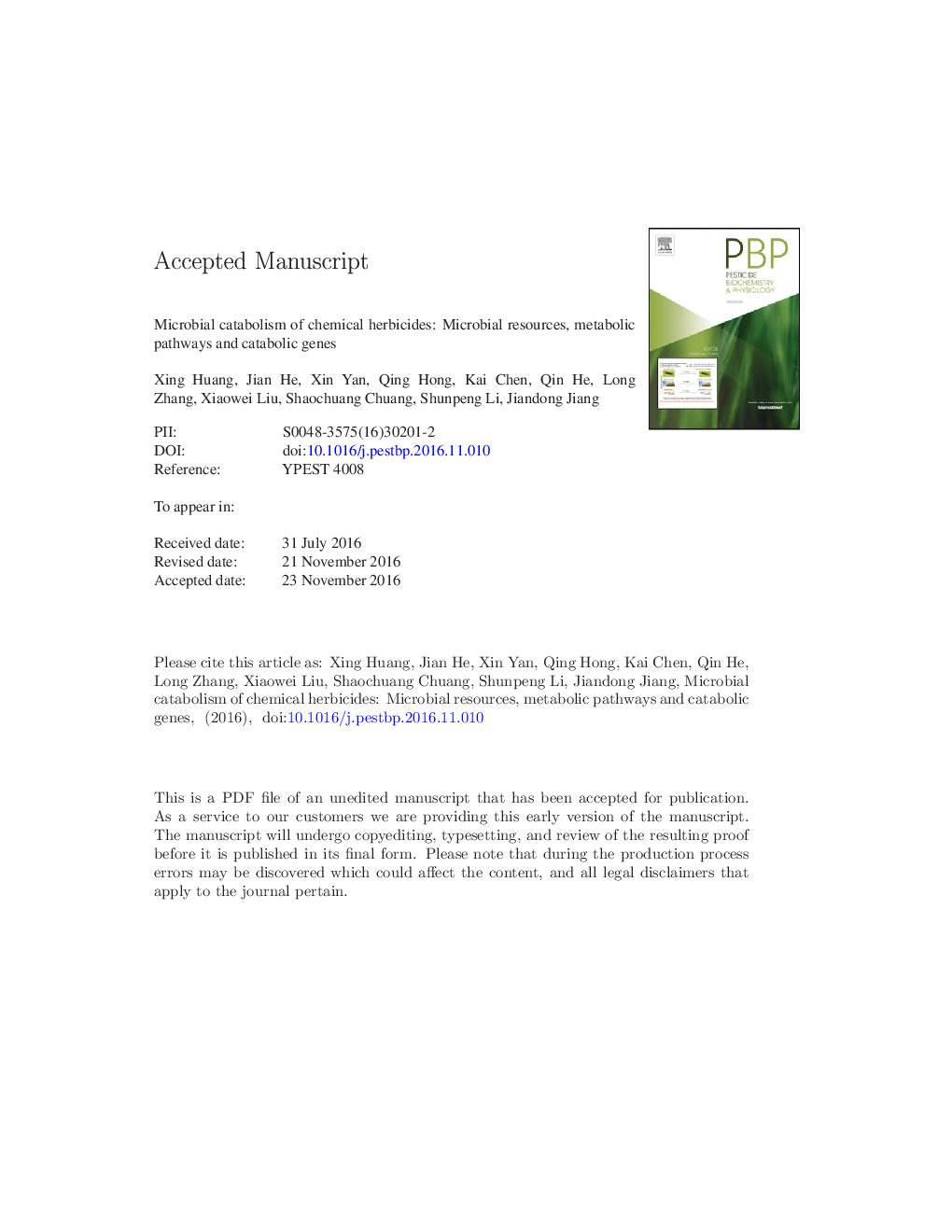| کد مقاله | کد نشریه | سال انتشار | مقاله انگلیسی | نسخه تمام متن |
|---|---|---|---|---|
| 8349260 | 1541756 | 2017 | 69 صفحه PDF | دانلود رایگان |
عنوان انگلیسی مقاله ISI
Microbial catabolism of chemical herbicides: Microbial resources, metabolic pathways and catabolic genes
دانلود مقاله + سفارش ترجمه
دانلود مقاله ISI انگلیسی
رایگان برای ایرانیان
کلمات کلیدی
MEAMNBA4-isopropylanilineEPTCAHASIPUIFTFenoxaprop-ethyldCMPGATAMPAESAMCPAHPPDEAGSTTHF2,4-D - 2،4-D2,4-dichlorophenoxyacetic acid - 2،4-dichlorophenoxyacetic اسیدAOPPs - AOPP هاN-acetyltransferase - N-استیل ترانسفرازDES - ازacetohydroxyacid synthase - استاتو هیدروکسی اکسید سنتازacetolactate synthase - استاتولاکتانت سنتاز2-methyl-4-chlorophenoxyacetic acid - اسید 2-متیل-4-کلروفنوکسی استاتیکaminomethylphosphonic acid - اسید آمینو متیل فسفونیکAmba - امباIsoxaflutole - ایسوکسافلوتولIsoproturon - ایسپروتورونALS - بیماری اسکلروز جانبی آمیوتروفیکtetrahydrofolate - تتراهیدروفولاتBiodegradation - تجزیه زیستیPhenylurea herbicides - علف کش های فنیلوریHerbicides - علفکشMetabolic pathway - مسیر سوخت و سازHydroquinone - هیدروکینونglutathione-S-transferase - گلوتاتیون S-ترانسفرازGlyphosate - گلیفوزات
موضوعات مرتبط
علوم زیستی و بیوفناوری
علوم کشاورزی و بیولوژیک
علوم زراعت و اصلاح نباتات
پیش نمایش صفحه اول مقاله

چکیده انگلیسی
Chemical herbicides are widely used to control weeds and are frequently detected as contaminants in the environment. Due to their toxicity, the environmental fate of herbicides is of great concern. Microbial catabolism is considered the major pathway for the dissipation of herbicides in the environment. In recent decades, there have been an increasing number of reports on the catabolism of various herbicides by microorganisms. This review presents an overview of the recent advances in the microbial catabolism of various herbicides, including phenoxyacetic acid, chlorinated benzoic acid, diphenyl ether, tetra-substituted benzene, sulfonamide, imidazolinone, aryloxyphenoxypropionate, phenylurea, dinitroaniline, s-triazine, chloroacetanilide, organophosphorus, thiocarbamate, trazinone, triketone, pyrimidinylthiobenzoate, benzonitrile, isoxazole and bipyridinium herbicides. This review highlights the microbial resources that are capable of catabolizing these herbicides and the mechanisms involved in the catabolism. Furthermore, the application of herbicide-degrading strains to clean up herbicide-contaminated sites and the construction of genetically modified herbicide-resistant crops are discussed.
ناشر
Database: Elsevier - ScienceDirect (ساینس دایرکت)
Journal: Pesticide Biochemistry and Physiology - Volume 143, November 2017, Pages 272-297
Journal: Pesticide Biochemistry and Physiology - Volume 143, November 2017, Pages 272-297
نویسندگان
Xing Huang, Jian He, Xin Yan, Qing Hong, Kai Chen, Qin He, Long Zhang, Xiaowei Liu, Shaochuang Chuang, Shunpeng Li, Jiandong Jiang,